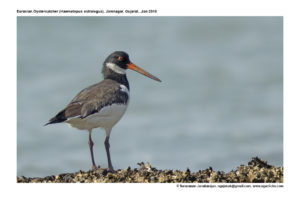Eurasian Oyster Catcher

Eurasian Oystercatcher Haematopus ostralegus
Etymology:
- Haematopus : Greek word haima –blood; pous – foot
- Ostralegus: Latin word ostrea –oyster; legere –to gather
Vernacular Names: Sind: Dobah, Hindi: Darya gajpaon, Pun: Ghogakhor, Guj: Daraiaiabalakh, Abalakh, Mar: Kalwafoda, Te: Yerra kali ulanka
Distribution in India: Resident of North West India and wide spread visitor in India.
Description: Size of 40–47·5 cm,wt.425–805g ( Male),445–820g (Female), wingspan 76–86 cm .The breeding adult has its head, neck and upper breast all black. The scapulars, upperwing-coverts and tail are also black. It has broad white wingbar from inner secondaries to middle primaries, becoming narrower and more broken distally. The middle and lower back, rump, uppertail-coverts, lower breast and belly are white. The eye and eyering are red, bill orange-red, legs pink. The female is similar to male, but averages slightly larger with longer, thinner bill. Juvenile resembles adult with drab-coloured eye, eyering, bill and legs, and pale fringes to upperpart feathers; white neck collar develops in first winter. The Races differ mainly on bill length and extent of white wingbar.
Habitat: It breeds on saltmarshes, sand and shingle beaches, less often on rocky coasts. In non-breeding season, mostly found on estuarine mudflats, but also saltmarshes and sandy and rocky shores.
Food habits: The diet of oystercatchers varies with location. The species occurring inland feed upon earthworms and insect larvae.The diet of coastal oystercatchers is more varied, although dependent upon coast type; on estuaries bivalves, gastropods and polychaete worms are the most important part of the diet, whereas rocky shore oystercatchers prey upon limpets, mussels, gastropods, and chitons. Other prey items include echinoderms, fish, and crabs.
Breeding habits: They breed in Apr–May. The males are opportunistically bigamous and female–female pairings also occur within polygynous relationships, but pair-bonds are typically long-term. The nest is a shallow scrape in ground, sometimes lined with shell and rock fragments, small mammal droppings. Nests built in open or within short vegetation, sometimes in clearings in taller vegetation. May sometimes re-use same nest scrape in subsequent season .They lay a clutch 2–4 eggs. The Incubation period is 24–35 days. The incubation is done by both sexes; usually starting with final egg.The fledging period is 28–37 days.